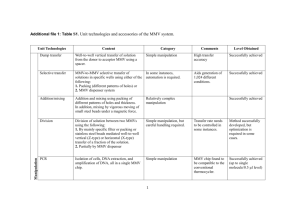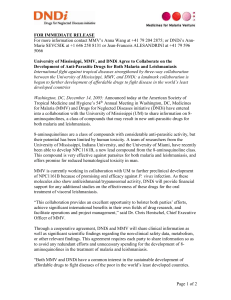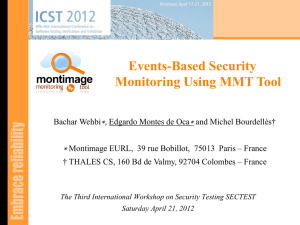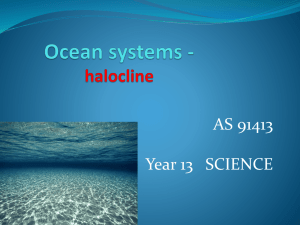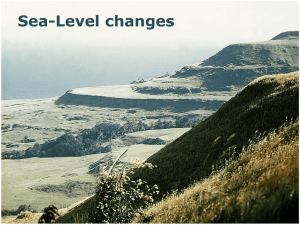Paleoclimate indicators
advertisement
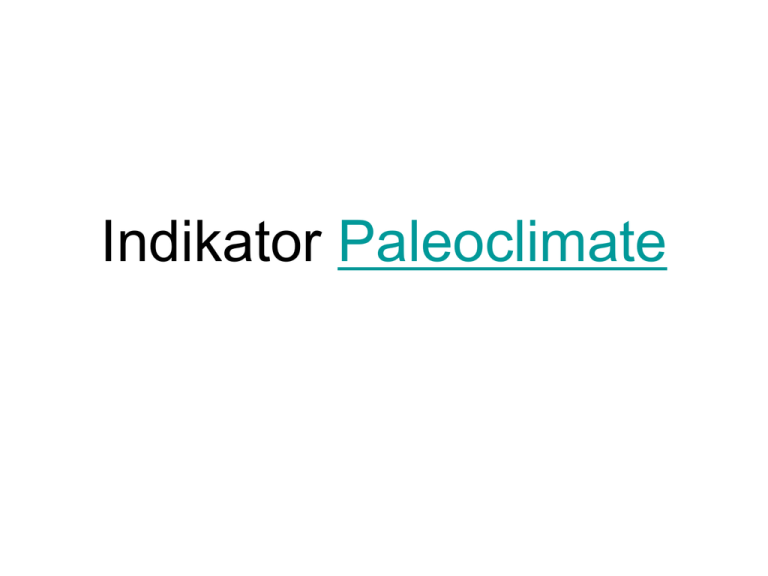
Indikator Paleoclimate Apa itu ITU PALEOKLIMAT?? • The study of past climates prior to the instrument record. • Scientists use indirect evidence (data) during past time periods to determine the climate at that time period. • These climate imprints are referred to as proxies. Mengapa belajar PALEOKLIMAT?? • Akan membantu kita mengetahui bagaimana iklim itu berubah-ubah sepanjang masa. • Untuk memperkirakan perubahan iklim di masa datang. Warm Cold Warm Apa yg. menyebabkan Iklim berubah sepanjang jaman? Penyebabnya sangat kompleks, dan inilah beberapa sebab tsb: 1. 2. 3. 4. Perubahan output matahari Perubahan orbit Bumi Perubahan dalam distribusi benua Perubahan isi gas rumah kaca di atmosfer. 1. Perubahan penyinaran matahari (Milancovic cycle) 2. Perubahan orbit bumi? • Mungkin karena asteroid yg. Menabrak bumi dan memunculkan bulan • tetapi.. • Sangat tinggi perubahan musim di daerah tropis Orbital forcing: Milankovitch Theory • Obliquity (miring): 41,000 yr cycle Orbital forcing: Milankovitch Theory Eccentricity - aneh: 100,000 years Orbital forcing: Milankovitch Theory Precession: 19,000-23,000 years The major axis of each planet's elliptical orbit also precesses within its orbital plane, in response to perturbations in the form of the changing gravitational forces exerted by other planets. This is called perihelion precession. It is generally understood that the gravitational pulls of the sun and the moon cause the precession of the equinoxes on Earth which operate on cycles of 23,000 and 19,000 years. Orbital scale insolation change • Strong 23 ky (precession) and 40 k cycles (Obliquity) • 100 ky cycle is not obvious 3. Perubahan distribusi benua; jenis batuan dapat digunakan sebagai indikator iklim Ordovician • The Ordovician (pron.: /ɔrdəˈvɪʃən/) is a geologic period and system, the second of six of the Paleozoic Era, and covers the time between 485.4 ± 1.9 to 443.4 ± 1.5 million years ago (ICS, 2004[5]). It follows the Cambrian Period and is followed by the Silurian Period. • Sea levels were high during the Ordovician; in fact during the Tremadocian, marine transgressions worldwide were the greatest for which evidence is preserved in the rocks. • During the Ordovician, the southern continents were collected into a single continent called Gondwana. Gondwana started the period in equatorial latitudes and, as the period progressed, drifted toward the South Pole. Early in the Ordovician, the continents Laurentia (presentday North America), Siberia, and Baltica (present-day northern Europe) were still independent continents (since the break-up of the supercontinent Pannotia earlier), but Baltica began to move towards Laurentia later in the period, causing the Iapetus Ocean to shrink between them. The small continent Avalonia separated from Gondwana and began to head north towards Baltica and Laurentia. The Rheic Ocean between Gondwana and Avalonia was formed as a result. Hot House World (300-5 Ma) Mesozoic/Cenozoic) • Thermal max: 55 Ma (Cenozoic) • Clues: – Marine T proxies – Tropical plants fossils, alligator, & pollens up in the arctic – Organic-rich deposit (anoxia) – Much lighter in δ18O (-40‰ vs. 0 of ocean, and vs. -25 ‰ if melt all ice now. Must have additional T effects.) – No glaciomarine deposit Causes of the hot house? • Tectonic block circum polar current can’t form arctic ice sheet? • Can’t form deep water since there is no strong T gradient (est. 12ºC vs. ~0 now) • CH4 Clathrate release>> positive greenhouse feedback – supported by lighter δ13C Land mass distribution • Higher tropical albedo (Land albedo > ocean) Accumulation of significant thicknesses of limestone and Reef-bearing limestone is restricted to ~20º + - equator Gondwana tillite, Ontario Rock record of glaciation, this one ~2.3 billion years ago! The concept of climate proxies • A climate proxy is something that records or reflects a change in temp or rainfall but does not DIRECTLY measure temperature or precipitation For example… Tree Rings Sediment Cores Pollen Examples of Climate Proxies Stable Isotopes Ice Cores Coral Reefs Serrations on leaf margins indicate temperature: jagged edges indicate cooler climate Leaf waxiness is an indicator of moisture retention Tree rings:degree of seasonality In the tropics there is no difference in growing seasons and tree rings are not well developed. These are tree rings from a tree in a temperate climate • • • • • • • Tree-ring-1 Tree-ring-2 Tree-ring-3 Tree-ring-4 Tree-ring-5 Tree-ring-6 Tree-ring-7 Vegetation zones in Europe parallel latitude now and 9,000 yr before present Middle Cretaceous climate indicators W = warmwater animal occurrences; E = evaporite minerals; C = coal deposits. Coal is not particularly temp sensitive but animals and evaporation are. Stable isotopes of oxygen: a proxy for temperature but now considered an almost direct measurement • Stable isotopes: do not decay over time. Ex, O16 and O18. O18 is produced from O16 through nucleosynthesis in supernovae Anything that incorporates oxygen into its chemical structure will do so with some ratio of O18:O16. We can measure the ratios of these isotopes in the lab O18/O16 fractionation H2O is evaporated from sea water. The oxygen in the H2O is enriched in the lighter O16. This H2O condenses in clouds,falling on land as precipitation. Thus, H2O that is part of the terrestrial water cycle is enriched in the light O16 isotope and sea water is enriched in the heavier O18 isotope Glacial ice is therefore made up primarily of water with the light O16 isotope. This leave the oceans enriched in the heavier O18, or “more positive.” During glacial periods, more O16 is trapped in glacial ice and the oceans become even more enriched in O18. During interglacial periods, O16 melts out of ice and the oceans become less O18 rich, or “more negative” in O18 If we collect a shell made out of CaCO3, we can analyze the O18:O16 ratio by the following formula: delta O18= [(O18/O16 sample/O18/O16 standard) -1 ] x1000 The standard that your sample is compared to is either one prepared from ocean water or from a fossil standard. Positive delta O18 values mean that your sample is enriched in the heavy O isotope; negative delta O18 values mean it’s depleted in the heavy O18. Curve of average O18 isotope variation over the past 2my based on analysis of deep sea sediment The curve illustrates changes in global ice volume in successive glacial (blue) and interglacial (green) cycles of the Quaternary Period. Note that this graph does not show fluctuating temperatures, but changes in the dilution of sea water as a result of freshwater influx from melting glacial ice, i.e., this is a climate proxy Sr87/Sr86 a proxy for salinity/rainfall (evap vs prec) During wet climates, more Sr is released from weathering minerals in granite Middle Cretaceous and early Tertiary temperatures A reconstruction of changing atmospheric CO2 levels (blue) and resulting global temps (pink) over the past 100 my, based on analysis of climate proxies such as pollen, leaf serration, and O18 values. Note that the Mid-Late Cretaceous was significantly warmer than the early Tertiary (or today) Not proxies, but direct measures Sr:Ca ratios in aragonite: a measure of seawater temperature Trace elements such as cadmium, barium, manganese and strontium replace Ca in the lattice of aragonite (a CaCO3 mineral). These trace elements often substitute for Ca as a result of climate-related variables. The following relationship between Sr:Ca ratios and temp was developed: Sr:Ca x 103 = 10.48 (=/- 0.01) - 0.0615 (+/- 0.0004) x temp. Thus we can measure trends in Sr:Ca ratios in coral aragonite skeletons as a way to determine surface sea water temps. Ocean surface temps and climate in the Tertiary Surface temps measured in shellbearing sediment from the western Pacific Ocean. Relatively warm surface waters from 49-35 M.a. are followed by a climate change to cooling and the buildup of glaciers. By 2.5 M.a. the onset of glaciation in the Northern hemisphere occurred, several M.a. after it started in Antarctica. Hypothesize about the Cambrian climate of VT Although zonal, the zones can be compressed Zonal compression can result from changes in the movement of heat from the equator to poles Take away points.. • What is a “climate proxy?” • What are examples of: geochemical proxies? biological proxies? lithologic proxies? When you see how paleoclimate reconstruction for a geologic period, can you describe the various techniques used to create it? • • • • Ice core proxy Pollen Coral skeleton Speleothem • Weather and climate observations can be found in ships logs, farmers’ diaries, newspaper accounts, and other written records. • Sediment cores can be taken from lakes, the shallow ocean, or the deep ocean. • In some cases the thickness of these layers can be used to infer past climate. • In other cases, these layers are composed of organic material that can be analyzed for other climate proxies. • Pollen grains are well preserved in lake and ocean sediment. • The analysis of each of these sediment layers provides information on the vegetation present at that time. • Scientists can infer past climates (warm or cold) based on the distribution and changes in plant species. • The most common element used in climate studies is oxygen. • The isotopes of oxygen are: –O18 (rare) –O17 –O16 (common) • The ratio of O18 to O16 is affected by temperature and can be used as a climate proxy. • Corals are composed of calcium carbonate. • This carbonate contains isotopes of oxygen that can be used to determine the water temperature when and where the corals grew. • As snow and ice accumulate in polar glaciers a paleoclimate record accumulates of the environmental conditions of the time of formation. • Ice cores can analyzed using stable isotope approaches for water or air bubbles within the ice as a record of past atmospheric • gas concentrations. • Tree growth is influenced by climate. These patterns can be seen in tree ring width and isotopic composition. • Trees generally produce one ring each year. • Trees ring records can extend back to the last 1000 years. Semua contoh-contoh yang digunakan secara individu atau bersama-sama dapat membantu mengumpulkan iklim masa lalu jangka waktu atau wilayah tertentu

